Water heating scheme: types of systems, types of wiring and
Water heating is the most efficient and economical heating system for housing. Various water heating schemes have been developed, and we want to consider their characteristics, advantages and features of operation in the conditions of a private house.
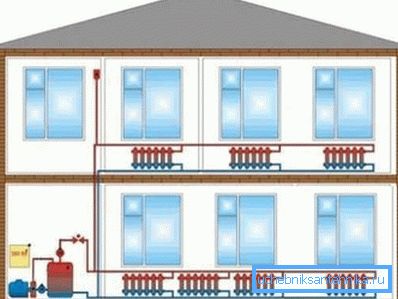
Heating with liquid coolant
General information
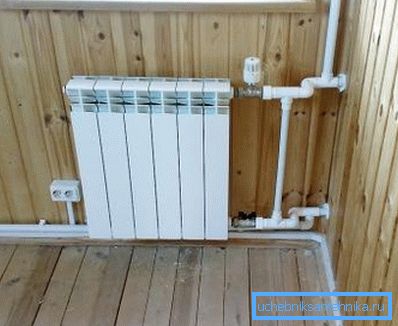
The main indicator of the comfort of any dwelling is the air temperature in it, since a person can live only in a narrowly-marked temperature range. However, in the continental latitudes of the northern hemisphere of our planet, the climate is far from this range, and people are forced to use artificial heat sources.
Previously, such a source was an open fire in a cave or a hut, then the fire moved to the furnace of the furnace located in the house. However, as the population grew, the issue of shortage of firewood and other types of fuel became more acute, and the person faced the problem of increasing heating efficiency.
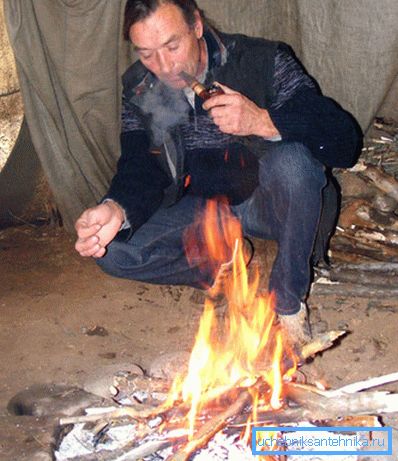
Note! Thus, the idea of using a heat carrier, a substance that plays the role of an intermediary in the transfer of heat from the flame to the air in the house, appeared.
The problem is that the gases conduct the heat poorly, and if you have a large house, then it will take a long time to heat the remote rooms to heat the oven, it will be too hot near the furnace, and cold in the remote rooms. Therefore, the main task was to supply heat with minimal losses to each room.

At this stage, we can formulate the main requirements for the coolant:
- High thermal conductivity. Necessary for the fastest possible heating of the coolant;
- High heat capacity. This parameter determines the ability of a substance to store thermal energy. It is obvious that the more heat is stored and transmitted by the intermediary, the more efficiently the system works;
- High mobility. The substance must have such properties as it is possible to transport it indoors without the use of sophisticated technology;
- Availability. The coolant should be inexpensive and available in different regions, as in the event of an accident it will need urgent replacement to avoid freezing at home;
- Security. Substance-agent should not pose a danger to humans and the environment, contain flammable, toxic, explosive or chemically aggressive compounds and substances.
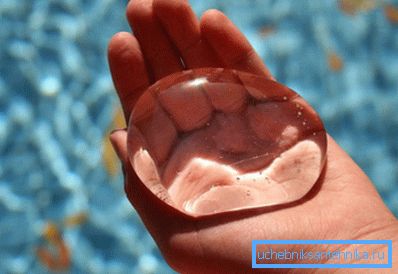
Note! The most suitable substance for all the listed parameters was ordinary water, which has the highest heat capacity among liquids, is able to move through pipes and channels under the action of gravity or pressure, is safe and incredibly widespread.
Thus, the task was specified: it is necessary to create a scheme in which water will move along a strictly defined route from the furnace firebox to heating appliances.
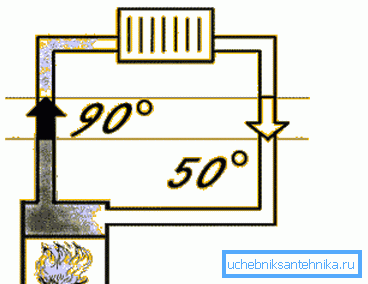
Note! To put it simply, we need two heat exchangers and a pipe through which water will circulate between them. One heat exchanger is installed in the furnace, where the liquid will heat up, and the second - in the room, where the coolant will give the stored energy to the air.
Heating boilers

If the source of heat energy is fuel, then the boiler is the means to obtain it. This is the heart of any heating system with a coolant. The efficiency of the entire heating depends on the reliability of this device, and in the conditions of Russian winters it is one of the conditions for survival, therefore the first task is the choice of the boiler.
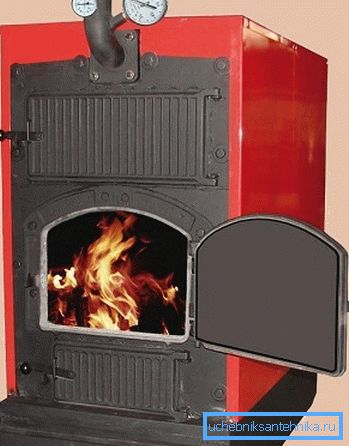
The most important criterion here is the availability and cost of fuel on which the unit will operate.
There are such types of boilers, depending on the fuel used:
- Solid fuel or wood boilers. Firewood, coal, coke, peat, pellets, briquettes and other types of combustible biomass are used;
- Gas. Use of trunk, compressed or liquefied natural gas;
- Diesel heating boilers. Liquid petroleum products are used: diesel fuel, diesel fuel, various oils, gasoline, kerosene, etc .;
- Electric. Heat the water by heating or electrode method.

If we talk about efficiency in terms of the cost of one kilowatt-hour of heat, as well as the availability and prevalence of fuel, then gas and wood-burning units are the undoubted favorites, the former being the most preferred.
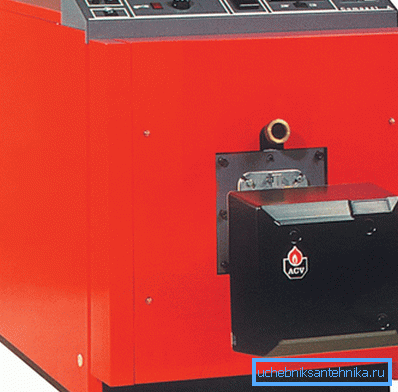
Note! If your house is connected to a gas transmission system, then you should buy a gas boiler, if the highway is not connected, then you should choose a wood-burning option. Electricity and diesel are too expensive for the average consumer.
Types of systems
With natural circulation

The heating circuit with natural water circulation is the simplest and cheapest, but also the most inefficient system. With small house sizes and heating areas, this is a completely working version, the construction of which does not require serious calculations and complicated installation work.
The principle of operation of such a system is simple: the boiler is installed at the lower point of the room, better - in the basement. Water fills the pipeline consisting of a supply pipe going upwards from the boiler, then the pipe gradually descends and passes through all the rooms, and finally returns to the heat exchanger of the furnace.
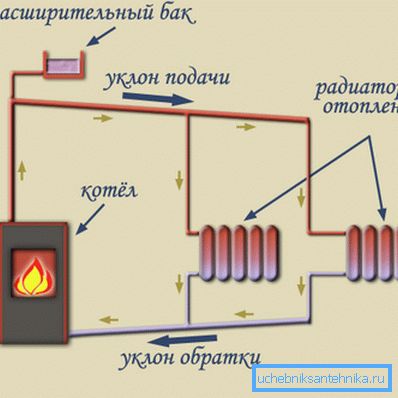
When the burner is turned on, the water begins to heat up, expands and rises upward through the pipe due to the difference in density between the hot and cold liquid. As the circuit is closed, the cold mass of the coolant is displaced into the heat exchanger, and the liquid begins to circulate in the system in a circle, transferring heat from the flame to the radiators.
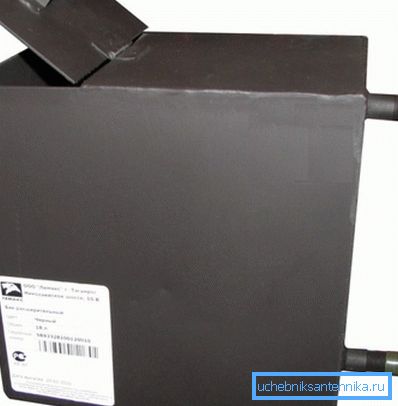
In order to compensate for the expansion and increase in the total water volume in the pipes, an expansion tank is installed at the top point. It can be open, as the pressure in the pipes does not matter.
Note! It is necessary to know and take into account the rules for the selection of pipe diameters and angles of inclination. It is believed that a slope of 5 mm per linear meter of pipe is sufficient; a clone is made in the direction of water movement.
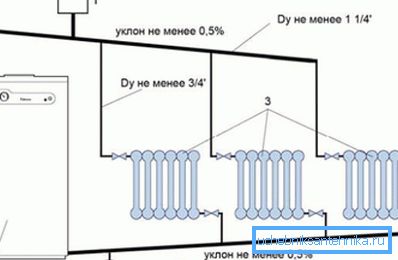
For servicing small village houses such a scheme is quite acceptable. It does not require calculations and is performed according to the standard scheme “like everyone else”, since the sizes and architecture of houses do not have any particular differences. Moreover, the design is relatively easy to assemble with your own hands and requires a minimum of materials.
With forced circulation
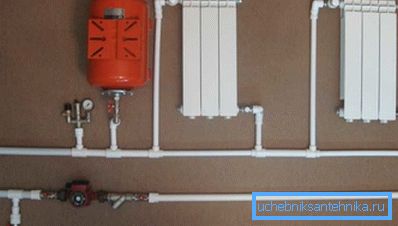
A more advanced and efficient heating system is a scheme with forced circulation of the coolant. This solution allows you to speed up the movement of water through the pipes and deliver the still hot liquid to the remote premises. The forced movement of water is carried out due to the pump built into the pipeline.

Due to the precisely calculated driving speed, the working efficiency is increased, fuel consumption is reduced and comfort in rooms is increased. For the creation of complex, branched and multi-circuit systems, forced circulation is necessary.
The construction of such a structure will require more serious calculations of hydraulics, selection and installation of a circulation pump, installation of protection, a closed accumulator, pressure gauges and safety valves. At the same time, there are no special requirements for the inclination of pipes.

Note! During operation, the circulation pump does not create all the pressure that is present in the system. The point is that the circuit is closed, and the water in it rotates like a wheel, and the pump overcomes only the hydraulic resistance and friction, so the energy consumed by it does not affect the cost of heating.
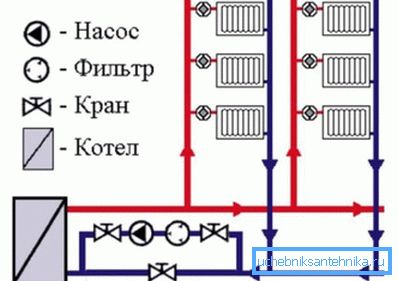
From the calculations it became known that the use of a circulating pump increases the efficiency of work by 25–30%. In addition, for normal maintenance of multi-storey buildings, multi-circuit and collector circuits, the use of forced circulation is necessary. Almost all modern systems use this principle.
Radiator wiring
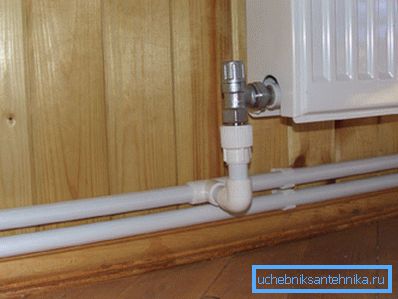
Another important difference of water heating systems is the type of pipe wiring from the boiler to the radiators.
There are three main types of such layout:
- One pipe design. This is the most simple and cheap model when heating batteries are connected to one pipe in series. Water enters through the supply pipe to the first radiator, passes through it and enters the same pipe from which it enters the next device, cooling as it moves;
- Two-pipe model. A more complicated, but also more efficient design, in which the batteries are connected by an input to the supply pipe, and the output to the return, and there is no other message between these pipes. Parallel connection allows you to warm up all the devices evenly, which increases work efficiency and comfort;
- Collector Beam Connection assumes the supply of coolant to the distribution manifold supply, from where pipes to the entrance of each radiator. From the outlets, the pipes return to the return header, and from there the water enters the boiler. This approach allows you to organize multi-circuit systems of warm floors and large houses with many rooms.
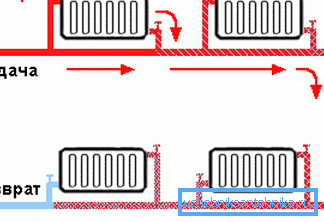
The one-pipe supply organization is suitable for small houses with natural circulation, or for individual rooms - summer kitchens, workshops, saunas, etc.
The two-pipe scheme is considered more efficient due to the uniform heating of the devices, the possibility of adjusting the temperature in individual rooms, and more precise control of the automation equipment. It is suitable for any type of building and is used most often.
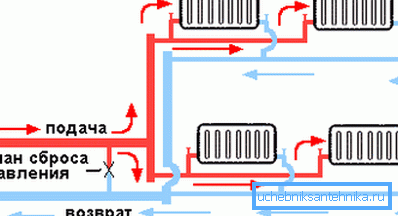
Collector wiring is the most efficient and advanced, but its price is significantly higher due to the greater number of pipes, the need for additional equipment, valves, as well as through complex installation and calculation.
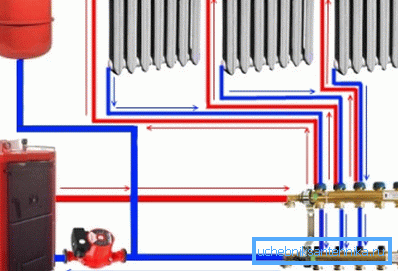
Note! Today, the most common two-pipe and mixed wiring, which can be combined with collectors of warm floors.
Conclusion
Water heating is the only truly efficient heat supply system in terms of price-quality ratio. It should be understood that the equipment and organization's schemes are constantly being improved, and the comparison of fashionable alternative systems with old types of water heating is absurd and unconvincing. The video will help you better understand this issue.